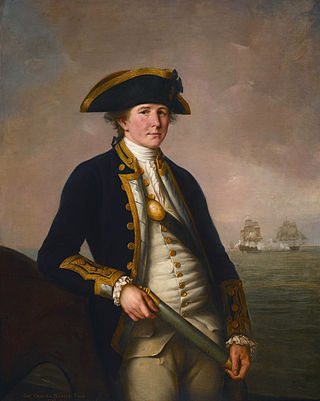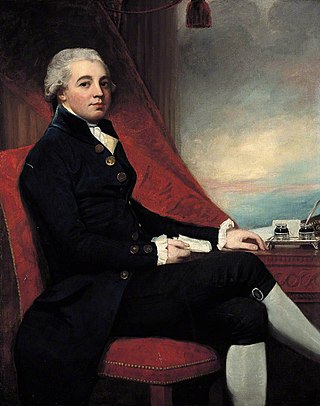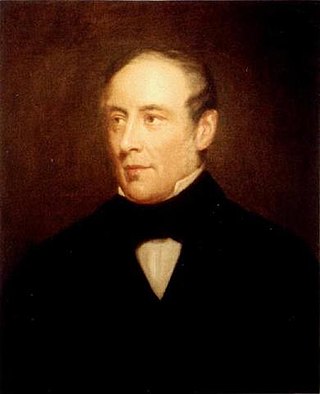Related Research Articles

The Bank of England is the central bank of the United Kingdom and the model on which most modern central banks have been based. Established in 1694 to act as the English Government's banker, and still one of the bankers for the Government of the United Kingdom, it is the world's eighth-oldest bank. It was privately owned by stockholders from its foundation in 1694 until it was nationalised in 1946 by the Attlee ministry.

The Royal Military College (RMC), founded in 1801 and established in 1802 at Great Marlow and High Wycombe in Buckinghamshire, England, but moved in October 1812 to Sandhurst, Berkshire, was a British Army military academy for training infantry and cavalry officers of the British and Indian Armies.

Admiral Thomas Graves, 1st Baron Graves, KB was a British officer of the Royal Navy and a colonial official. He served in the Seven Years' War and the American War of Independence. He was also the Commodore-Governor of Newfoundland for a period of time.

The governor of the Bank of England is the most senior position in the Bank of England. It is nominally a civil service post, but the appointment tends to be from within the bank, with the incumbent grooming their successor. The governor of the Bank of England is also chairman of the Monetary Policy Committee, with a major role in guiding national economic and monetary policy, and is therefore one of the most important public officials in the United Kingdom.

Admiral of the Fleet Sir Charles Morice Pole, 1st Baronet GCB was a Royal Navy officer, colonial governor and banker. As a junior officer he saw action at the siege of Pondicherry in India during the American Revolutionary War. After taking command of the fifth-rate HMS Success he captured and then destroyed the Spanish frigate Santa Catalina in the Strait of Gibraltar in the action of 16 March 1782 later in that War.

Nehemiah Rice Knight was Governor of Rhode Island and United States Senator from Rhode Island.

Thomas Raikes was a British merchant particularly trading from London with Russia, a banker and newspaper proprietor. Notably, he was Governor of the Bank of England during the 1797 currency crisis, when the Bank was prohibited by the British Government from paying out in gold.
Samuel Hurd Walley was a Massachusetts businessman and politician who served as Speaker of the Massachusetts House of Representatives and as a member of the U.S. representative from Massachusetts.

Andrew John Bailey is a British central banker who has been Governor of the Bank of England since 16 March 2020.

The 1802–03 United States Senate elections were held on various dates in various states. As these U.S. Senate elections were prior to the ratification of the Seventeenth Amendment in 1913, senators were chosen by state legislatures. Senators were elected over a wide range of time throughout 1802 and 1803, and a seat may have been filled months late or remained vacant due to legislative deadlock. In these elections, terms were up for the senators in Class 1.
William Mellish was an English Tory politician and banker.

St John's Cathedral is a heritage-listed, Anglican cathedral in Parramatta, City of Parramatta, Sydney, New South Wales, Australia. St John's was given the status of provisional cathedral of the Anglican Diocese of Sydney in 1969, and designated a Regional Cathedral in 2011 for the Western Region. It was added to the New South Wales State Heritage Register on 5 March 2010.

Hugh Colin Smith was an English banker who was Governor of the Bank of England from 1897–99.
Charles Savage was Governor of the Bank of England from 1745 to 1747. He had been Deputy Governor from 1743 to 1745. He replaced William Fawkener as Governor and was succeeded by Benjamin Longuet.
Charles Palmer was Governor of the Bank of England from 1754 to 1756. He had been Deputy Governor from 1752 to 1754. He replaced Alexander Sheafe as Governor and was succeeded by Matthews Beachcroft.
Edward Payne was Governor of the Bank of England from 1771 to 1773. He had been Deputy Governor from 1769 to 1771. He replaced William Cooper as Governor and was succeeded by James Sperling. Payne's tenure as Governor occurred during the Bengal bubble crash (1757–1769) and the Crisis of 1772.
Peter Gaussen (1723–1788) was Governor of the Bank of England from 1777 to 1779.
Benjamin Winthrop was Governor of the Bank of England from 1804 to 1806. He had been Deputy Governor from 1802 to 1804. He replaced Joseph Nutt as Governor and was succeeded by Beeston Long.
Henry James Prescot was Governor of the Bank of England from 1849 to 1851. He had been Deputy Governor from 1847 to 1849. He replaced James Morris as Governor and was succeeded by Thomson Hankey.

Alfred Latham (1801–1885) was an English businessman and banker, born in Camberwell to Thomas Latham (1746–1818), a merchant and plantation owner, and his wife, Ann Jones. Inheriting wealth, Latham went into business in 1824, and went into partnership in what became the Arbuthnot Latham bank in 1833, with John Alves Arbuthnot (1802–1875).
References
- ↑ Governors of the Bank of England. Archived 23 February 2006 at the Wayback Machine Bank of England, London, 2013. Archived here. Retrieved 9 March 2016.